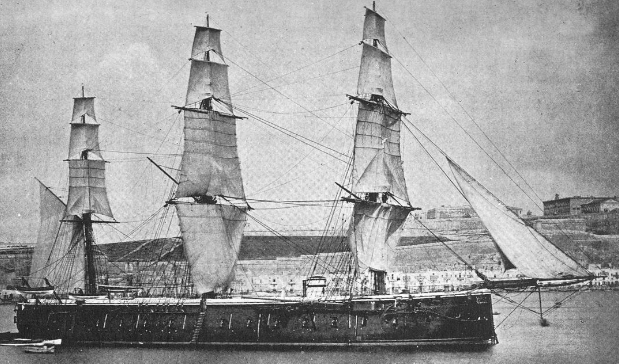1848-1914
Alfred Cracknell was born in Paddington on 19 November 1848 and baptised on 14 January 1849 at St. Mary, Paddington Green; the family address at the time was Sheldon Street, Paddington.
Alfred’s parents, Daniel Cracknell & Eliza Cracknell (nee Johnson), had married on 21 January 1846 at St. Mary, Paddington Green. Daniel had been born circa 1821 in Banham, a small village in Norfolk and Eliza had been born circa 1825 in the Parish of St. George, Hanover Square.
Alfred was the first child of Daniel & Eliza but by the 1851 Census they also had a daughter, Matilda Eliza and were living at 49 Paddington Street. By the 1861 Census the family had grown further and were living in Leinster Street, Paddington with 5 children: Alfred aged 12, Matilda 10, Emily 3, Frederick 5 and Alice 1. Alfred’s father is described as a ‘painter’.
Alfred joins the Royal Navy
On 19 January 1863 Alfred enlisted with the Royal Navy as 24610 Boy A. Cracknell, initially for 2 years until he reached the age of 18. His parents had to give written permission for him to enlist as he was under-age. He served on various ships including Implacable, Royal Oak, Marlborough and the Severn.
HMS Royal Oak
On the 1871 Census, Alfred is 23 and an Ordinary Seaman serving aboard HMS Rocket.
Desertion
A few months after the census though, on 13 October 1871, Daniel deserted whilst his ship was docked in Montevideo, Uruguay. However, he was found, returned to the ship and on return to the UK was placed in jail in Lewes, Sussex. He deserted again at Devonport on 19 September 1871 and his name appears on a list of wanted RN deserters (dated 15.3.1872). The record describes Alfred as having “brown hair, light eyes and 5ft 1in tall”.
Marriage
The next time we find Alfred is on his marriage on 7 June 1874 to Elizabeth Kate BAKER at All Saints, Notting Hill. Alfred gives his occupation and that of his father Daniel as ‘painter’; Elizabeth’s father is Phillip Baker a ‘coachman’. The witnesses were Frederick George Cracknell (probably Alfred’s brother) and Georgina LEGG. There is no evidence of any children from the marriage.
Death of Alfred’s father
Sadly, on 9 April 1880, Alfred’s father, Daniel, was admitted to Banstead Aslyum, Epsom. I haven’t been able to discover why but the 1881 Census describes him as a ‘lunatic”. Daniel died 2 years later, on 26 January 1882 aged 61.
In Court
On 2 November 1880 we find Alfred in trouble again – this time he’s appearing at Clerkenwell Court, having been charged, on 28 October 1880, with “maliciously attempting to wound Alfred THOMPSON, with intent to do him grievous bodily harm, and unlawfully assaulting the said Alfred THOMPSON to prevent his lawful apprehension for misdemeanor”. Alfred pleaded guilty and was given 6 months at Cold Bath Fields Prison in Clerkenwell.
Cold Bath Fields Prison (also known as the Middlesex House of Correction and Clerkenwell Goal) was situated near Mount Pleasant in Clerkenwell. The prison was closed in 1885.
1881 Census
On the 1881 census, Alfred is listed as a prisoner at Cold Bath Fields Prison, Clerkenwell (registered simply under his initials, A.C.) and described as married and a painter.
Despite extensive research, Alfred’s wife Elizabeth Kate cannot be located on any census before or after their marriage.
In 1881, Alfred’s mother Eliza was living at 19 Leinster Street, Paddington with sons, Edward 18 and Arthur 11. Alfred’s father, Daniel is in Banstead Aslyum, Epsom (registered simply under his initial’s “D.C.” and described as a patient/lunatic. His mother died 1885.
Alfred’s journey to the workhouse and then to the asylum
On 26 May 1883, A. William Cracknell, aged just 34, was admitted to Paddington Workhouse, Harrow Road), address Leinster Street, but discharged the following month on 26 June 1883.
The following year, on 15 September 1884, A.William Cracknell, aged 35 of 19 Leinster Street, was admitted to Westminster Workhouse for being “destitute” but discharged the following day and admitted to Bethnal Green Asylum.
The 1901 Census confirms that Alfred aged 42, born Paddington, married and a ‘painter’ is a patient in Bethnal Green Asylum, Bethnal House, Cambridge Road. Alfred remained in Bethnal Green Asylum/Workhouse until 6 May 1902 (Horton record says 1901) when he’s transferred to London County Council Horton Asylum, Epsom.
On admission, the Horton case notes described Alfred as having “dementia”. In April 1912, he’s described as having “secondary dementia” and being in “moderate health, having considerable vascular degeneration”.
‘A Quiet Old Dement’
On 16 September 1912 the notes stated, “A quiet old dement who answers questions simply and rationally. He gives no trouble and works contentedly in the vegetable shed.” The following year, on 16 March 1913 the notes say “no change to report. He is a quiet old dement, getting too feeble to walk. I cannot get any evidence of delusions.”. Later in 1913 it states “appears in fair health for an old man willing to work. Says the place cannot get on without him.”
Sadly, on 14 October 1914 at 10:35pm Alfred had a syncope attack lasting 55mins and died at 11:30pm. He was 65 years old. Following a post-mortem, the cause of death was given as “aneurism of the aorta” and “hypertrophy of the heart”. Alfred was buried at Horton Asylum in Plot 1255a on 19th April.




